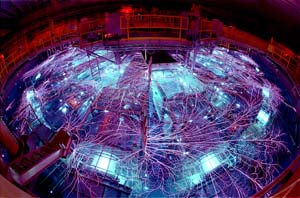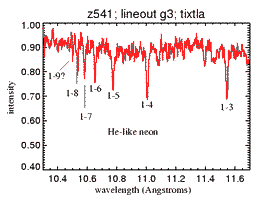
and Active Galactic Nuclei (AGNs). Photoionization is also important in my favorite objects: Hot Stars.
Here are some papers about X-ray photoionized astrophysical plasmas:
|
Astrophysics Experiments can be done
in the laboratory -- and with the launch of Chandra
and XMM, X-ray spectroscopy of
cosmic plasmas will be much more like X-ray spectroscopy of hot laboratory plasmas, and can
benefit from the benchmarking of plasma emission properties in the lab.
Here is a nice set of pages put together by Dick Lee at Livermore about astrophysics on large lasers. There are already several experimental campaigns (and associated theoretical efforts) underway: |
|
Herbig-Haro jets (from forming stars) are being
modeled in the laboratory using laser ablation. The radiative
properties of different materials are shown to affect the jet structure.
There are several experimental campaigns to study the growth of hydrodynamic instabilities -- often to model supernovae explosions. Astrophysics--especially solar physics--has long benefitted from the spectroscopy of collisional (coronal) plasmas produced in Tokamaks. Here's a nice recent paper on Fe L-shell emission. Also check out the Swarthmore Spheromak Experiment, in which magnetic reconnection in plasmas -- a process that may contribute to coronal heating on the Sun -- is studied. |
|
A lot of interesting cosmic plasmas are not collisional/coronal, however, but rather
are dominated by photoionization. These tend to exist around compact
objects, where gravitational potential energy is being efficiently converted
to hard (hn > 1 keV) X-ray continuum radiation.
This includes X-ray Binaries (XRBs)
 and Active Galactic Nuclei (AGNs). Photoionization is also important in my favorite objects: Hot Stars. Here are some papers about X-ray photoionized astrophysical plasmas: |
|
X-ray spectral properties of general photoionized plasmas -- Liedahl
et al. 1990, Ap.J., 350, L37
X-ray observations and modeling of the XRBs Vela X-1 -- Sako et al. 1999, Ap.J., 525, 921 -- and Cyg X-3 -- Liedahl & Paerels 1996, Ap.J., 468, L33 The strong influence of X-ray photoionization on hot star winds -- MacFarlane, Cohen, & Wang 1994, Ap.J., 437, 351 |
|
Here is a presentation
I gave at the NIF Science
Workshop in October 1999 on experiments that could be done on NIF
involving the creation and characterization of a low-density, gradient
free, X-ray photoionized plasma -- essentially an X-ray nebula.
(Power-point viewers can be obtained at this
page, or a large, zipped postscript file of the presentation can be downloaded from ftp.bartol.udel.edu/cohen/nif/nif-talk.ps.zip).
Note that Z-pinches provide enough X-ray flux to do some interesting experiments today... |
 |
This is a picture of the PBFA-II pulsed-power facility at Sandia National Lab as it discharges, sending 20MA of current into the Z-pinch wire array. |
|
In fact, we have just begun an experimental campaign, led by Jim Bailey, to measure X-ray absorption (and eventually emission)
spectra from a neon-filled gas cell placed several cm from the Z-pinch. The X-rays from the pinch
ionize the neon and also provide a backlighting source for making the absorption measurements. We intend
to use data from these experiments to benchmark the ionization balance and temperature as a function of ionization
parameter for a series of gases that are commonly seen in photoionized cosmic X-ray sources. We will
see which spectral lines are present and how their relative strengths depend on the ionization parameter (which is
essentially a ratio of the X-ray flux to electron density in a plasma).
Here is part of our first neon absorption spectrum. A 1 cm cell filled with 30 Torr of neon shows many strong He-like absorption features in a time-integrated spectrum.

|
| Return to David's Home Page |